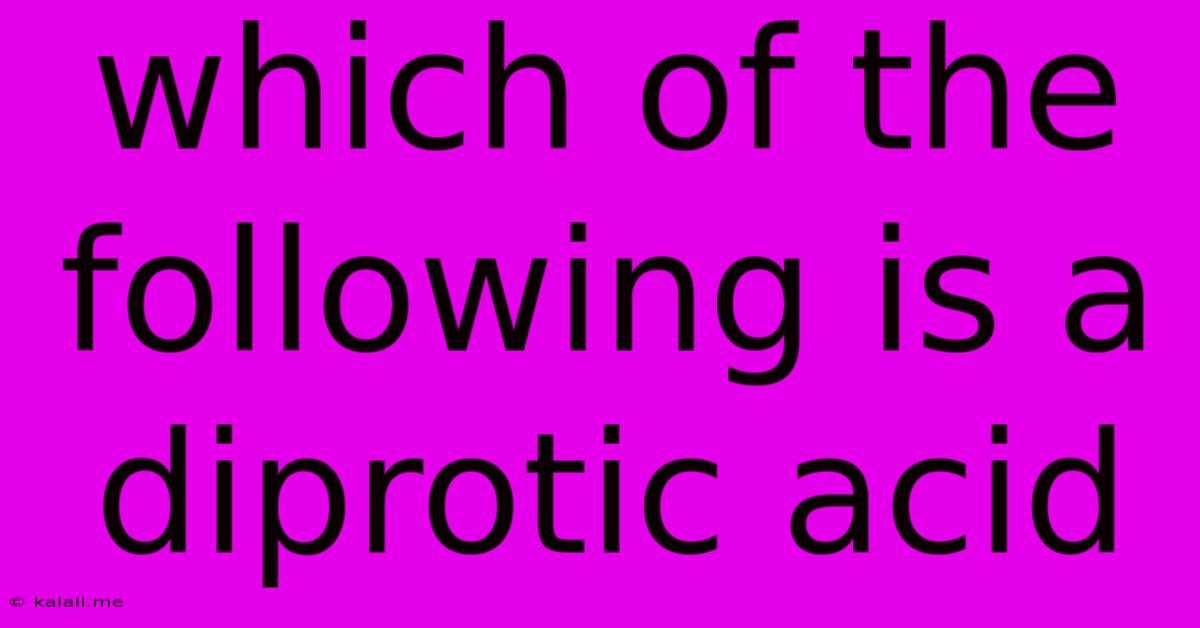Which Of The Following Is A Diprotic Acid
Kalali
Jun 14, 2025 · 2 min read

Table of Contents
Which of the Following is a Diprotic Acid? Understanding Acid Strength and Proton Donation
This article will explore the concept of diprotic acids and help you identify them from a list of potential candidates. Understanding diprotic acids is crucial in chemistry, impacting various fields from industrial processes to biological systems. We'll define diprotic acids, explain how they differ from monoprotic and polyprotic acids, and provide examples to solidify your understanding.
What is a Diprotic Acid?
A diprotic acid is an acid that can donate two protons (H⁺ ions) per molecule in an aqueous solution. This means it undergoes two successive ionization steps. The strength of each ionization step can vary; it might be strong in the first step and weak in the second, or vice versa, or even both weak. The key characteristic is the potential to release two protons.
Differentiating Diprotic from Monoprotic and Polyprotic Acids:
- Monoprotic acids: These acids can donate only one proton per molecule (e.g., HCl, HNO₃). They undergo only one ionization step.
- Diprotic acids: As discussed, these acids can donate two protons per molecule (e.g., H₂SO₄, H₂CO₃). They undergo two ionization steps.
- Polyprotic acids: This is a broader category encompassing acids that can donate more than one proton per molecule. Diprotic acids are a subset of polyprotic acids. Examples include phosphoric acid (H₃PO₄), which is triprotic (donates three protons).
Identifying Diprotic Acids:
To identify a diprotic acid from a given list, look for molecules with two ionizable hydrogen atoms. These hydrogen atoms are typically bonded to highly electronegative atoms like oxygen. The presence of two acidic protons is the defining feature.
Examples of Diprotic Acids:
Several common acids fall into the diprotic category:
- Sulfuric acid (H₂SO₄): A strong diprotic acid, widely used in various industrial processes.
- Carbonic acid (H₂CO₃): A weak diprotic acid, crucial in maintaining blood pH and crucial in many natural processes.
- Oxalic acid (C₂H₂O₄): A relatively weak diprotic acid found in many plants.
- Hydrogen sulfide (H₂S): A weak diprotic acid with a characteristic rotten egg smell.
How to Approach a "Which of the Following" Question:
When presented with a multiple-choice question asking to identify a diprotic acid, systematically examine each molecule:
- Count the ionizable hydrogen atoms: Look for molecules with two hydrogen atoms bonded to highly electronegative atoms (usually oxygen).
- Consider the molecular structure: Examine the chemical formula and structure to confirm the presence of two acidic protons. Understanding chemical structures greatly aids in this process.
- Review acid strength: While not essential for identification, noting whether the acid is strong or weak can provide additional context.
By following these steps, you'll be able to confidently identify diprotic acids from a list of chemical compounds. Remember to focus on the number of ionizable protons as the primary determinant. Understanding the nuances of acid strength further enhances your comprehension of acid-base chemistry.
Latest Posts
Latest Posts
-
Provides Flexible Support Is What Tissue
Jun 15, 2025
-
Describe The Relationship Between Force Mass And Acceleration
Jun 15, 2025
-
Which Of The Following Statements About Average Speed Is Correct
Jun 15, 2025
-
What Is The Lcm Of 10 And 14
Jun 15, 2025
-
What Family Does Potassium Belong To
Jun 15, 2025
Related Post
Thank you for visiting our website which covers about Which Of The Following Is A Diprotic Acid . We hope the information provided has been useful to you. Feel free to contact us if you have any questions or need further assistance. See you next time and don't miss to bookmark.